Jian Guan
Trust-Region Adaptive Policy Optimization
Dec 19, 2025Abstract:Post-training methods, especially Supervised Fine-Tuning (SFT) and Reinforcement Learning (RL), play an important role in improving large language models' (LLMs) complex reasoning abilities. However, the dominant two-stage pipeline (SFT then RL) suffers from a key inconsistency: SFT enforces rigid imitation that suppresses exploration and induces forgetting, limiting RL's potential for improvements. We address this inefficiency with TRAPO (\textbf{T}rust-\textbf{R}egion \textbf{A}daptive \textbf{P}olicy \textbf{O}ptimization), a hybrid framework that interleaves SFT and RL within each training instance by optimizing SFT loss on expert prefixes and RL loss on the model's own completions, unifying external supervision and self-exploration. To stabilize training, we introduce Trust-Region SFT (TrSFT), which minimizes forward KL divergence inside a trust region but attenuates optimization outside, effectively shifting toward reverse KL and yielding stable, mode-seeking updates favorable for RL. An adaptive prefix-selection mechanism further allocates expert guidance based on measured utility. Experiments on five mathematical reasoning benchmarks show that TRAPO consistently surpasses standard SFT, RL, and SFT-then-RL pipelines, as well as recent state-of-the-art approaches, establishing a strong new paradigm for reasoning-enhanced LLMs.
ReFusion: A Diffusion Large Language Model with Parallel Autoregressive Decoding
Dec 15, 2025Abstract:Autoregressive models (ARMs) are hindered by slow sequential inference. While masked diffusion models (MDMs) offer a parallel alternative, they suffer from critical drawbacks: high computational overhead from precluding Key-Value (KV) caching, and incoherent generation arising from learning dependencies over an intractable space of token combinations. To address these limitations, we introduce ReFusion, a novel masked diffusion model that achieves superior performance and efficiency by elevating parallel decoding from the token level to a higher slot level, where each slot is a fixed-length, contiguous sub-sequence. This is achieved through an iterative ``plan-and-infill'' decoding process: a diffusion-based planning step first identifies a set of weakly dependent slots, and an autoregressive infilling step then decodes these selected slots in parallel. The slot-based design simultaneously unlocks full KV cache reuse with a unified causal framework and reduces the learning complexity from the token combination space to a manageable slot-level permutation space. Extensive experiments on seven diverse benchmarks show that ReFusion not only overwhelmingly surpasses prior MDMs with 34% performance gains and an over 18$\times$ speedup on average, but also bridges the performance gap to strong ARMs while maintaining a 2.33$\times$ average speedup.
DynaAct: Large Language Model Reasoning with Dynamic Action Spaces
Nov 11, 2025Abstract:In modern sequential decision-making systems, the construction of an optimal candidate action space is critical to efficient inference. However, existing approaches either rely on manually defined action spaces that lack scalability or utilize unstructured spaces that render exhaustive search computationally prohibitive. In this paper, we propose a novel framework named \textsc{DynaAct} for automatically constructing a compact action space to enhance sequential reasoning in complex problem-solving scenarios. Our method first estimates a proxy for the complete action space by extracting general sketches observed in a corpus covering diverse complex reasoning problems using large language models. We then formulate a submodular function that jointly evaluates candidate actions based on their utility to the current state and their diversity, and employ a greedy algorithm to select an optimal candidate set. Extensive experiments on six diverse standard benchmarks demonstrate that our approach significantly improves overall performance, while maintaining efficient inference without introducing substantial latency. The implementation is available at https://github.com/zhaoxlpku/DynaAct.
AgentPRM: Process Reward Models for LLM Agents via Step-Wise Promise and Progress
Nov 11, 2025Abstract:Despite rapid development, large language models (LLMs) still encounter challenges in multi-turn decision-making tasks (i.e., agent tasks) like web shopping and browser navigation, which require making a sequence of intelligent decisions based on environmental feedback. Previous work for LLM agents typically relies on elaborate prompt engineering or fine-tuning with expert trajectories to improve performance. In this work, we take a different perspective: we explore constructing process reward models (PRMs) to evaluate each decision and guide the agent's decision-making process. Unlike LLM reasoning, where each step is scored based on correctness, actions in agent tasks do not have a clear-cut correctness. Instead, they should be evaluated based on their proximity to the goal and the progress they have made. Building on this insight, we propose a re-defined PRM for agent tasks, named AgentPRM, to capture both the interdependence between sequential decisions and their contribution to the final goal. This enables better progress tracking and exploration-exploitation balance. To scalably obtain labeled data for training AgentPRM, we employ a Temporal Difference-based (TD-based) estimation method combined with Generalized Advantage Estimation (GAE), which proves more sample-efficient than prior methods. Extensive experiments across different agentic tasks show that AgentPRM is over $8\times$ more compute-efficient than baselines, and it demonstrates robust improvement when scaling up test-time compute. Moreover, we perform detailed analyses to show how our method works and offer more insights, e.g., applying AgentPRM to the reinforcement learning of LLM agents.
Dual-level Progressive Hardness-Aware Reweighting for Cross-View Geo-Localization
Nov 03, 2025Abstract:Cross-view geo-localization (CVGL) between drone and satellite imagery remains challenging due to severe viewpoint gaps and the presence of hard negatives, which are visually similar but geographically mismatched samples. Existing mining or reweighting strategies often use static weighting, which is sensitive to distribution shifts and prone to overemphasizing difficult samples too early, leading to noisy gradients and unstable convergence. In this paper, we present a Dual-level Progressive Hardness-aware Reweighting (DPHR) strategy. At the sample level, a Ratio-based Difficulty-Aware (RDA) module evaluates relative difficulty and assigns fine-grained weights to negatives. At the batch level, a Progressive Adaptive Loss Weighting (PALW) mechanism exploits a training-progress signal to attenuate noisy gradients during early optimization and progressively enhance hard-negative mining as training matures. Experiments on the University-1652 and SUES-200 benchmarks demonstrate the effectiveness and robustness of the proposed DPHR, achieving consistent improvements over state-of-the-art methods.
Reinforcing Spatial Reasoning in Vision-Language Models with Interwoven Thinking and Visual Drawing
Jun 11, 2025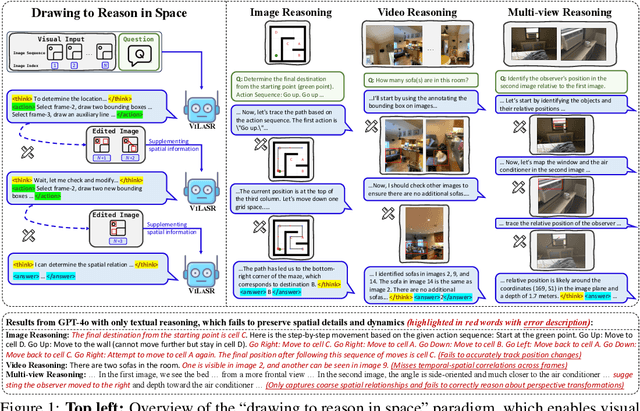
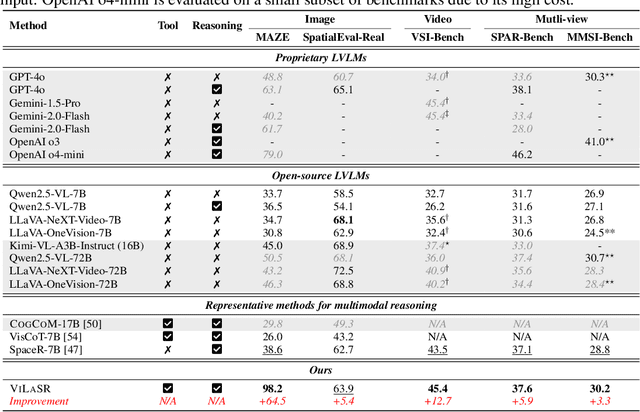


Abstract:As textual reasoning with large language models (LLMs) has advanced significantly, there has been growing interest in enhancing the multimodal reasoning capabilities of large vision-language models (LVLMs). However, existing methods primarily approach multimodal reasoning in a straightforward, text-centric manner, where both reasoning and answer derivation are conducted purely through text, with the only difference being the presence of multimodal input. As a result, these methods often encounter fundamental limitations in spatial reasoning tasks that demand precise geometric understanding and continuous spatial tracking-capabilities that humans achieve through mental visualization and manipulation. To address the limitations, we propose drawing to reason in space, a novel paradigm that enables LVLMs to reason through elementary drawing operations in the visual space. By equipping models with basic drawing operations, including annotating bounding boxes and drawing auxiliary lines, we empower them to express and analyze spatial relationships through direct visual manipulation, meanwhile avoiding the performance ceiling imposed by specialized perception tools in previous tool-integrated reasoning approaches. To cultivate this capability, we develop a three-stage training framework: cold-start training with synthetic data to establish basic drawing abilities, reflective rejection sampling to enhance self-reflection behaviors, and reinforcement learning to directly optimize for target rewards. Extensive experiments demonstrate that our model, named VILASR, consistently outperforms existing methods across diverse spatial reasoning benchmarks, involving maze navigation, static spatial reasoning, video-based reasoning, and multi-view-based reasoning tasks, with an average improvement of 18.4%.
Extended Inductive Reasoning for Personalized Preference Inference from Behavioral Signals
May 23, 2025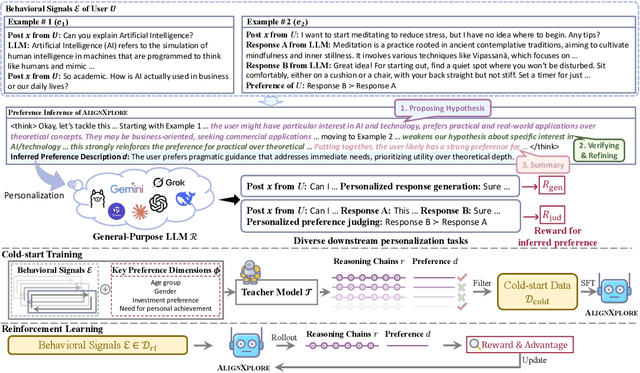

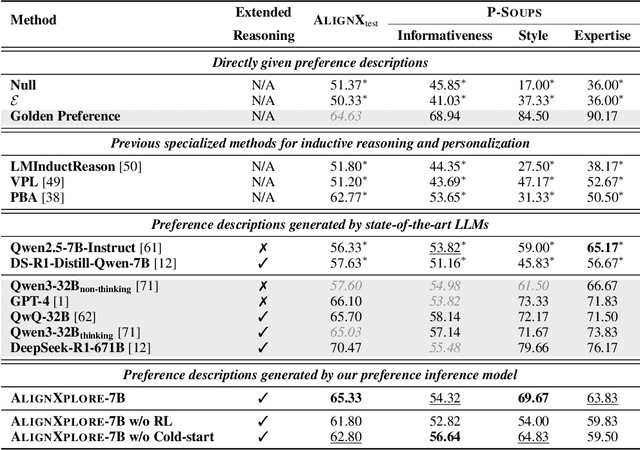
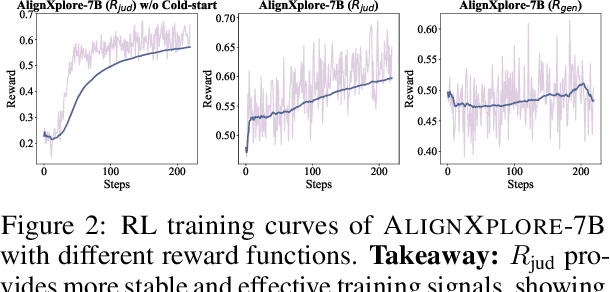
Abstract:Large language models (LLMs) have demonstrated significant success in complex reasoning tasks such as math and coding. In contrast to these tasks where deductive reasoning predominates, inductive reasoning\textemdash the ability to derive general rules from incomplete evidence, remains underexplored. This paper investigates extended inductive reasoning in LLMs through the lens of personalized preference inference, a critical challenge in LLM alignment where current approaches struggle to capture diverse user preferences. The task demands strong inductive reasoning capabilities as user preferences are typically embedded implicitly across various interaction forms, requiring models to synthesize consistent preference patterns from scattered signals. We propose \textsc{AlignXplore}, a model that leverages extended reasoning chains to enable systematic preference inference from behavioral signals in users' interaction histories. We develop \textsc{AlignXplore} by combining cold-start training based on synthetic data with subsequent online reinforcement learning. Through extensive experiments, we demonstrate that \textsc{AlignXplore} achieves substantial improvements over the backbone model by an average of 11.05\% on in-domain and out-of-domain benchmarks, while maintaining strong generalization ability across different input formats and downstream models. Further analyses establish best practices for preference inference learning through systematic comparison of reward modeling strategies, while revealing the emergence of human-like inductive reasoning patterns during training.
Latent Preference Coding: Aligning Large Language Models via Discrete Latent Codes
May 08, 2025Abstract:Large language models (LLMs) have achieved remarkable success, yet aligning their generations with human preferences remains a critical challenge. Existing approaches to preference modeling often rely on an explicit or implicit reward function, overlooking the intricate and multifaceted nature of human preferences that may encompass conflicting factors across diverse tasks and populations. To address this limitation, we introduce Latent Preference Coding (LPC), a novel framework that models the implicit factors as well as their combinations behind holistic preferences using discrete latent codes. LPC seamlessly integrates with various offline alignment algorithms, automatically inferring the underlying factors and their importance from data without relying on pre-defined reward functions and hand-crafted combination weights. Extensive experiments on multiple benchmarks demonstrate that LPC consistently improves upon three alignment algorithms (DPO, SimPO, and IPO) using three base models (Mistral-7B, Llama3-8B, and Llama3-8B-Instruct). Furthermore, deeper analysis reveals that the learned latent codes effectively capture the differences in the distribution of human preferences and significantly enhance the robustness of alignment against noise in data. By providing a unified representation for the multifarious preference factors, LPC paves the way towards developing more robust and versatile alignment techniques for the responsible deployment of powerful LLMs.
Scaling Video-Language Models to 10K Frames via Hierarchical Differential Distillation
Apr 03, 2025Abstract:Long-form video processing fundamentally challenges vision-language models (VLMs) due to the high computational costs of handling extended temporal sequences. Existing token pruning and feature merging methods often sacrifice critical temporal dependencies or dilute semantic information. We introduce differential distillation, a principled approach that systematically preserves task-relevant information while suppressing redundancy. Based on this principle, we develop ViLaMP, a hierarchical video-language model that processes hour-long videos at ``mixed precision'' through two key mechanisms: (1) differential keyframe selection that maximizes query relevance while maintaining temporal distinctiveness at the frame level and (2) differential feature merging that preserves query-salient features in non-keyframes at the patch level. Hence, ViLaMP retains full information in keyframes while reducing non-keyframes to their most salient features, resembling mixed-precision training. Extensive experiments demonstrate ViLaMP's superior performance across four video understanding benchmarks, particularly on long-form content. Notably, ViLaMP can process ultra-long videos (up to 10K frames) on a single NVIDIA A100 GPU, achieving substantial computational efficiency while maintaining state-of-the-art performance.
Align Your Rhythm: Generating Highly Aligned Dance Poses with Gating-Enhanced Rhythm-Aware Feature Representation
Mar 21, 2025Abstract:Automatically generating natural, diverse and rhythmic human dance movements driven by music is vital for virtual reality and film industries. However, generating dance that naturally follows music remains a challenge, as existing methods lack proper beat alignment and exhibit unnatural motion dynamics. In this paper, we propose Danceba, a novel framework that leverages gating mechanism to enhance rhythm-aware feature representation for music-driven dance generation, which achieves highly aligned dance poses with enhanced rhythmic sensitivity. Specifically, we introduce Phase-Based Rhythm Extraction (PRE) to precisely extract rhythmic information from musical phase data, capitalizing on the intrinsic periodicity and temporal structures of music. Additionally, we propose Temporal-Gated Causal Attention (TGCA) to focus on global rhythmic features, ensuring that dance movements closely follow the musical rhythm. We also introduce Parallel Mamba Motion Modeling (PMMM) architecture to separately model upper and lower body motions along with musical features, thereby improving the naturalness and diversity of generated dance movements. Extensive experiments confirm that Danceba outperforms state-of-the-art methods, achieving significantly better rhythmic alignment and motion diversity. Project page: https://danceba.github.io/ .
 Add to Chrome
Add to Chrome Add to Firefox
Add to Firefox Add to Edge
Add to Edge